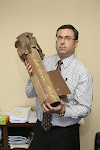The Iranian nuclear expert assassinated in Tehran on Monday was the top scientist and senior manager of Iran's nuclear effort. Majid Shahriari was killed when an explosive charge placed in his car was detonated by remote control after he climbed into the vehicle, according to a Western intelligence expert with knowledge of the operation.
The assassination carried the signature of Israel's Mossad, which has carried out similar operations on foreign soil over the decades. Typically, a team of agents reconnoiters the target and his routines over a period of months, assessing vulnerabilities and opportunities to escape afterward. Most of the operatives are usually on their way out of the country by the time the charge is detonated by a member who sees the target enter the booby-trapped car. "It's like a suit," says the intelligence expert. "An assassination must be custom-made." (See how Israel is pressing for a tougher U.S. line against Iran.)
Only political appointees ranked higher than Shahriari in Iran's nuclear effort. His death dealt a double blow to the Iranian nuclear program. The most immediate cost was the loss of operational expertise and detailed knowledge of an effort that has gone on for decades. But his death also brought home to every other scientist the risk of remaining in their line of work.
Like other senior nuclear scientists, Shahriari had been assigned bodyguards, according to Parviz Davoodi, head of Shahid Beheshti University, where Shahriari lectured on physics and held a position on the faculty of the department of nuclear engineering. Speaking to the Iranian press, the university president, who earlier served as Vice President under Iranian President Mahmoud Ahmadinejad, noted that security must be improved. (See the top 10 Ahmadinejad-isms.)
A second nuclear scientist escaped alive from a similar attack the same day. Fereydoun Abbasi was being driven to work, according to Iranian media reports, and may have escaped death because a bodyguard was at the wheel. Abbasi is an adviser to the Defense Ministry and a professor at Imam Hossein University, which is affiliated with the Revolutionary Guards Corps.
Contrary to the account given to TIME, Iranian officials insisted that motorcycles figured in both incidents, with riders attaching explosives to the exteriors of the cars. "In the second incident, the driver noticed the motorbike approaching and he distanced from it - that is why the explosion did not damage his car so badly," said Tehran police chief Hossein Sajedinia, according to the Fars news agency. (See pictures of terror in Tehran.)
Ahmadinejad blamed the attacks on the U.S. and Israel, referring to the latter as "the Zionist entity." In Israel, which regards Iran's nuclear ambitions as an existential threat, the news media made the same assumption, offering asides about the attacks in news stories announcing the appointment of a new head of Mossad. The daily Israel Hayom observed that Mossad's director, Meir Dagan, "will be leaving an organization that is far sharper and more operational than the organization he received, and all of the accusations from Tehran yesterday are a good indication of that. Iran will be the focal point for the next Mossad director too."
Among Dagan's known triumphs is the 2008 assassination of Imad Mughniyeh, the senior Hizballah official responsible for a series of terrorism attacks, including the 1983 attacks on the U.S. embassy and Marine barracks in Beirut, which killed more than 350 people. Mughniyeh perished in Damascus from the detonation of explosives hidden in the driver's headrest of his car. In response to the terrorism attacks on Israeli athletes in the 1972 Munich Olympics, Israel killed a series of Palestinian militants in the succeeding years. Among the victims was Muhammad Boudia, who died after an explosive placed under the driver's seat of his Renault was detonated by remote control on a Paris street in 1973.

